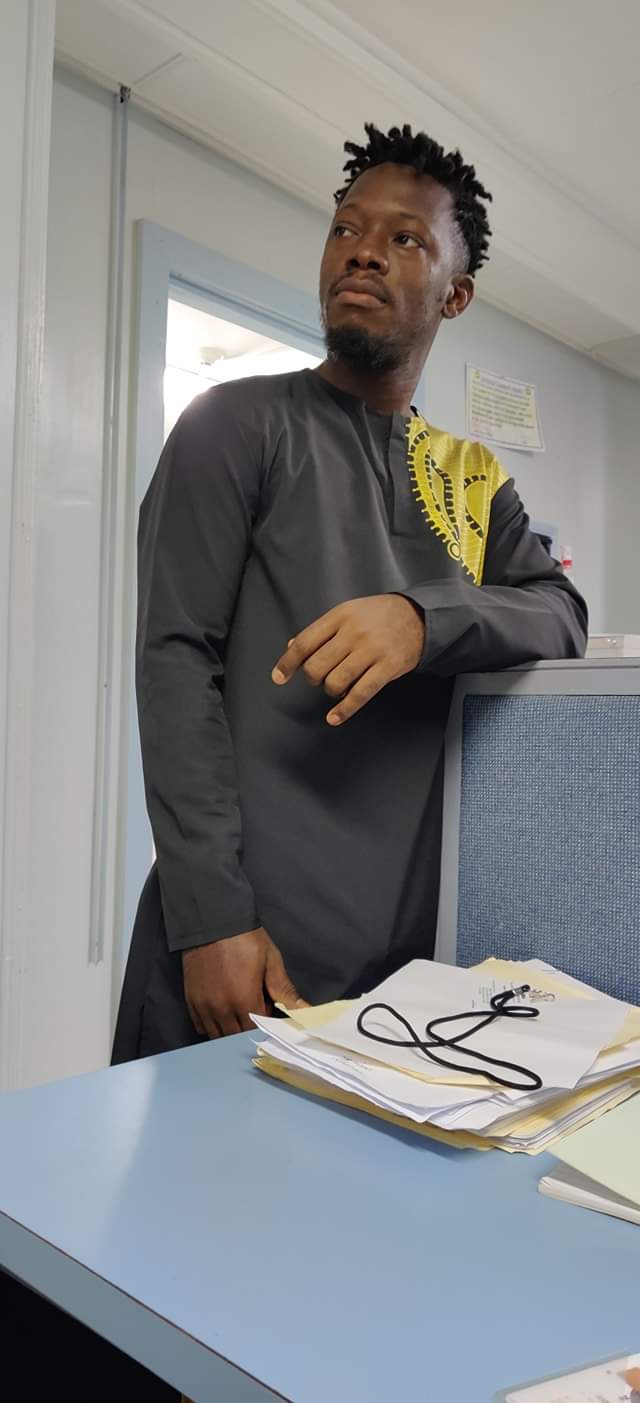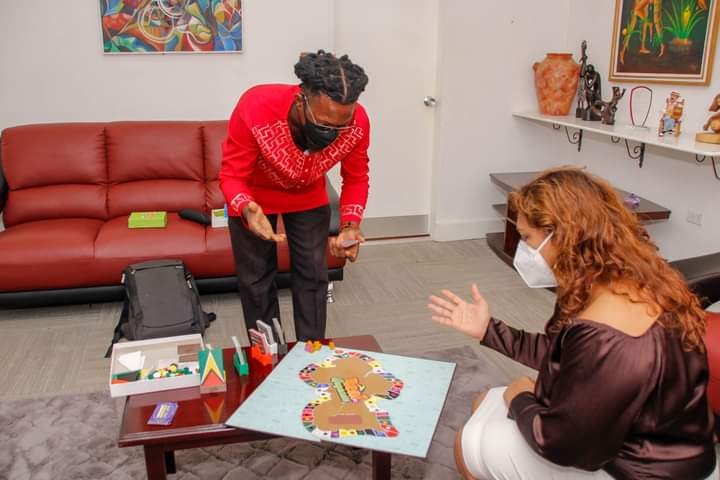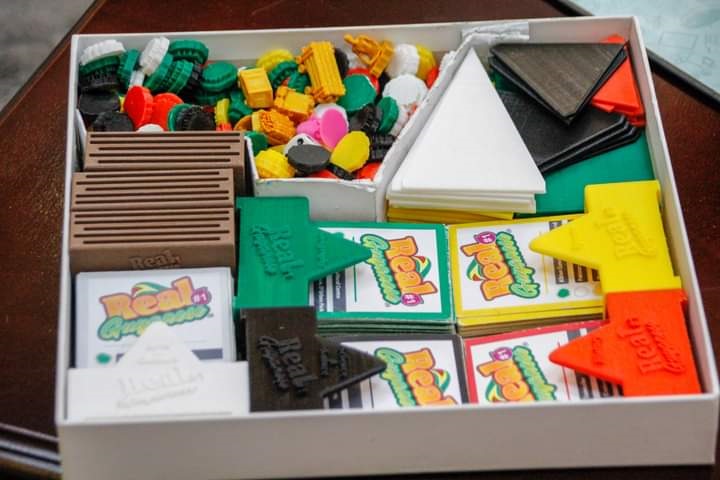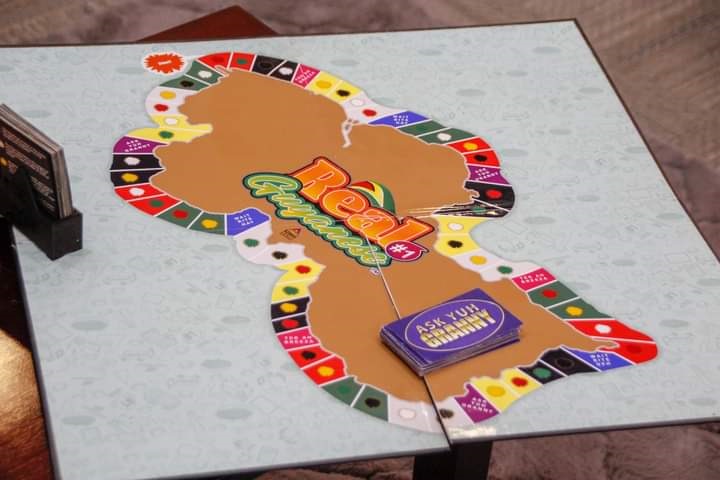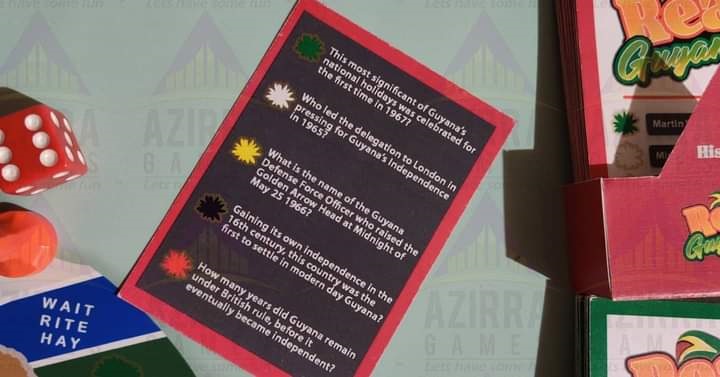Linden Cave, a former videographer at the Guyana Sugar Corporation (GuySuCo), has invented a trivia board game, Real #1 Guyanese.
The game’s board is in the shape of the map of Guyana and it has five sets of cards representing Arts and Culture, Science and Nature, History, Geography, and Sports, the categories on which the questions are based. All of the components of the game are manufactured locally except for the board itself and the dice, which are imported. It has already caught the attention of a number of Guyanese, including Minister of Education Priya Manickchand.
According to Cave, it all began one Saturday afternoon in May last year when he invited the youth group at his church – The World Vision New Testament Church of God – to his home for a social event. The occasion was to have the youths engage in fun activities that would foster better relationships. However, aside from the fun part of it, he also saw it as an opportunity to have the youths learn new things. He provided board games, but his guests were not too keen on playing because the game were foreign in nature, the rules not well known and therefore they were not as fun as they could have been. That was a light-bulb moment for Cave, who immediately thought that games featuring Guyana might be more fascinating.
By the next Monday, Cave already had a name picked out. He was still employed with GuySuCo at the time and talked his idea over with a colleague. Together they worked on the logo for his prospective business. The businessman gives all credit for the idea coming together to God, adding, “It was only God and me.”
The logo was only the beginning, as it took him more than a year to get it all set up. He shared that he did much research on the internet, checked out old newspaper articles, and visited the archives at the National Library, and the Guyana National Museum. Though he spent countless hours on his research, he did not find as much as he had hoped, especially in the area of sports. “While we have such a wonderful history, it is not well documented,” the entrepreneur said.
As a result, though the board game is ready for sale, Cave still continues to research to be able to add to the various categories. This, he noted, will allow for new editions of the game as time progresses.
To play the game, the person whose turn it is follows the spaces along the map according to the number shown when the dice are rolled. Each space is colour coded to indicate the category of card to be used. Each card has five questions with colours of the Golden Arrowhead assigned to each question. Not all the questions are to be answered in one turn. In fact, each colour-coded space has a dot of another colour that determines which question is to be answered.
There is also another set of cards labelled ‘Ask Yuh Granny’ that gives instructions to ‘Tek A Breezer’, ‘Wait Right Deh’ or ‘Ask Yuh Granny’. Based on the instruction, the player is allowed to ‘Tek A Breezer’ by not answering any questions. For ‘Wait Right Deh’ the player loses a turn. The ‘Ask Yuh Granny’ card can be kept until the player wishes to use it. It allows the player to not answer a question or instead having the other player read the question, get an additional turn. All question cards have the answers to the questions on the opposite side.
Cave said he did a survey in 2019 to see how people felt about the game and whether they would consider buying it. At the end of the game, he often had people asking for another chance to play the game, as they had an idea what it was all about or were reminded of an answer they had learnt years ago in school and believed they would be better prepared to conquer the game a second time around.Asked whether there was a favourite category, Cave could not say exactly, but he noticed the majority of his players shying away from the sports category. He said he totally understands this since his Facebook audience is about 76% women.
The game, he further said, was initially designed for children in Grade Six and up but he believes it could even be introduced to younger children, as they will catch on eventually and it would better for them to know about their country at an earlier age. Cave added that part of the reason he did not initially intend it for smaller children was because he will be making a junior version of the game.
Hoping for the best
One of his biggest challenges in making the board game possible was finance. Cave knew what he wanted but he did not have the resources necessary to make it happen. According to the man, when he considered the budget required to finish the project, he arrived at millions of dollars and later slashed it to $5 million. He recounted visiting different business, pitching his idea and seeking investment. But he said just about everyone was skeptical about betting on a new idea. Cave then decided that he was going to ask for much less and maybe persons would invest so he decided he was going instead ask for $100,000 from 50 people, but even then, almost everyone said no.
He said people told him that no matter how amazing his project was, they were not about to give their money to a stranger. “I remember this one guy that said to me, ‘I’m going to invest after you hit it big’ and I said to him, when I hit it big, I won’t need you. I thought that people would be more interested in the legacy attached to it, to say that ‘my family will share this accomplishment you have created…’ but people didn’t have time with that”, said Cave. He was eventually able to get someone to invest the required $5 million but even then it was not enough. He needs more money which he has since been working on.
Another of his challenges was printing the cards. “I tried to get some people to help me out with 3D printing but that didn’t work out so I actually had to go and learn as quickly as I could [to do 3D printing] …,” he added.
The pandemic also posed a challenge, adding to the reason people did not want to invest as well not being able to have people come together to play the game for reasons of social distancing.
“Asking people for money was something I had never even done. I felt many days, I wanted to take this whole thing and throw it in the garbage because you’re sitting there [until] 3 o’clock in the morning [doing] research and [saying] why am I doing this? Who cares? Everybody [is] on their cell phones, on social media. Who would play this boring game that you spending all this time behind? This is a waste of time. You should be looking into something else like a second job to provide for your family. But I didn’t feel like that every day. My only goal was just to finish this project and get into peoples’ homes and hope for the best,” he said.
In fact, Cave’s quest to make his dream a reality was such that he subsequently quit his job to pursue it. Colleagues and others questioned why he chose to leave his job in the middle of a pandemic when things were uncertain, especially when he had a family to take care of. But he believed he was on to something and he would rather try and fail than not to try at all.
“I can tell you my wife was very supportive. She works at the GPHC [Georgetown Public Hospital Corporation]. Actually the first person of all my friends I talked to, he came, and I told him about it. I first did this horrible looking board, but he said to me, ‘You might be on to something here. This look like it worth billions of dollars.’ And I was like maybe he knows what he is saying,” the father of three said.
Getting the government interested in the trivia game initially served as a challenge also. “I wrote to the President. I wrote the First Lady, Minister of Tourism, Minister of Sports, Youth and Culture, the Minister of Education but nobody responded to me. I still intended to go through with it,” he said. It was at this point that his wife’s manager, who was also a friend of Minister Manickchand, brought it to her attention. Cave was able to have a meeting with the minister and as he put it, “the rest was history.” He added that he did not have a lot of confidence that anything would have come out of the meeting, but Minister Manickchand was very encouraging.
“And that is what I’ve been telling people about. We don’t have to just sit and read the textbooks anymore. We condense the information of the textbooks into this game. She also encouraged me to look at some other materials for the other levels and go full circle. I was blown away that the minister was blown away,” said an ecstatic Cave. The ministry is on board to have the Real #1 Guyanese game introduced into schools.
His meeting with Minister Manickchand has led to his phone now ringing all the time. Already, Cave has more than 100 orders to fill. Many people, he said, see Real #1 Guyanese as the perfect Christmas gift and have placed their orders to have it in time for Christmas. People living abroad have also expressed their desire to have the game and Cave is currently working on a way to make shipping to them possible.
Cave is also working on other versions of the board game and is planning to introduce a Creolese board game next year.
He hopes to manufacture all the components of the game locally very soon. In addition, Cave said that he is open to making Real #1 Guyana the best it could possibly be and welcomes ideas from anyone interested in getting on board. Since his company has no brick and mortar location, the board game is being delivered to customers. Cave can be contacted at 624-0117.
